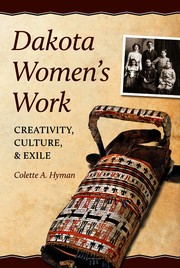
Dakota Women's Work
By Colette A. Hyman
Subjects: American Indian Tourist Art, Dakota Indian Material Culture, Fur Trade, Dakota Women Social Conditions, Quillwork, Women, economic conditions, Dakota Indian Art, Sioux Indian Wars, Sioux Indian Women, Native American Material Culture, Sioux Indian Quillwork, Sioux Indian Economic Conditions, Indian leatherwork, Indians of north america, industries, Sioux Indian Social Life and Customs, Dakota Women Economic Conditions, Dakota Women, Leatherwork, Sioux Indian Material Culture, Women, social conditions, Dakota Beadwork, Dakota Indian Economic Conditions, Sioux Indian Beadwork, Dakota History, Native American Treaties, Sioux Indian History, U.S. Dakota War, American Indian Material Culture, Dakota women, American Indian Art, Native American Tourist Art, Sioux Indian Art, Native American Art, Dakota beadwork, American Indian Treaties, Sioux Indian Women Social Conditions, Indians of North America, Star Quilts, Native American Industries, Dakota Women History, Indians of north america, west (u.s.), Economic conditions, Industries, Beadwork, Catholic Missions, Dakota Indians, Women, history, American Indian Industries, Santee Sioux Indians, Native American Social Life and Customs, Social conditions, American Indian Social Life and Customs, Reservation Life, Sioux Indian Women Economic Conditions, History, Sioux Indians, Sioux Indian Women History
Description: A tiny pair of beaded deerskin moccasins, given to a baby in 1913, provides the starting point for this thoughtful examination of the work of Dakota women. Mary Eastman Faribault, born in Minnesota, made them almost four decades after the U.S.–Dakota War of 1862. This and other ornately decorated objects created by Dakota women—cradleboards, clothing, animal skin containers—served more than a utilitarian function. They tell the story of colonization, genocide, and survival. Author Colette Hyman traces the changes in the lives of Dakota women, starting before the arrival of whites and covering the fur trade, the years of treaties and shrinking lands, the brutal time of removal, starvation, and shattered families after 1862—and then the transition to reservation life, when missionaries and government agents worked to turn the Dakota into Christian farmers. The decorative work of Dakota women reflected all of this: native organic dyes and quillwork gave way to beading and needlework, items traditionally decorated for family gifts were produced to sell to tourists and white collectors, work on cradleboards and animal skin bags shifted to the ornamenting of hymnals and the creation of star quilts. Through it all, the work of Dakota women proclaims and retains Dakota identity: it is a testament to the endurance of Dakota traditions, to the survival of the Dakota in exile, and—most vividly—to the role of women in that survival. -- from back cover.
Comments
You must log in to leave comments.